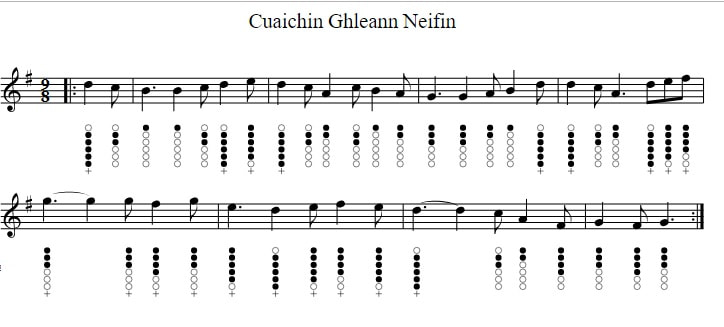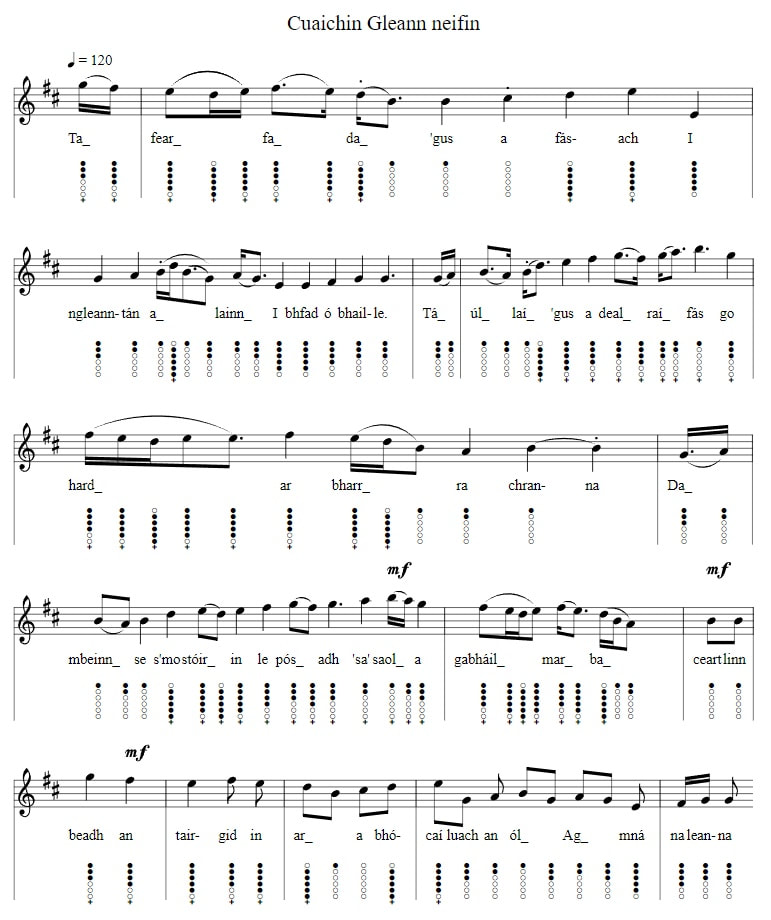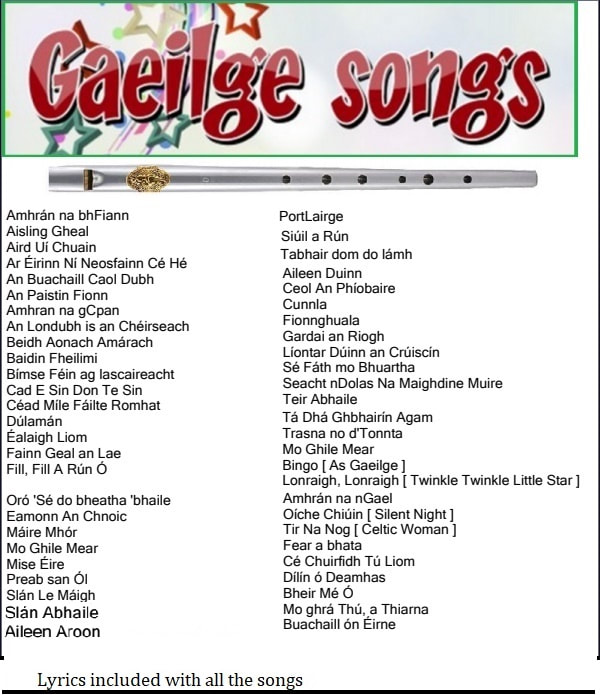Cuaichin Gleann neifin Song Lyrics And Guitar Chords
The melody to this song was used as the theme tune to Glenroe but its a beautiful song. Chords here based on the Colcannon recording of the song. The tin whistle sheet music notes are included. Gaeilge songs .
The traditional Irish song, 'Cuaichín Ghleann Neifin', has been an integral part of Irish music and culture for centuries. Also known as 'The Little Cuckoo of the Glen of Nephin', this song has stood the test of time and has been passed down through generations, preserving the rich heritage and history of Ireland.
The origins of 'Cuaichín Ghleann Neifin' can be traced back to the 18th century, when it was first recorded by the renowned Irish harpist and composer, Turlough O'Carolan. O'Carolan was known for his unique style of blending traditional Irish music with classical influences, and 'Cuaichín Ghleann Neifin' is a perfect example of this fusion. The song is a slow air, commonly played on the harp, and its haunting melody evokes a sense of longing and nostalgia for the Irish landscape.
The lyrics of 'Cuaichín Ghleann Neifin' are in the Irish language, and they paint a vivid picture of the glen of Nephin, a mountain range in County Mayo. The song speaks of the beauty of the glen, with its rolling hills, green pastures, and the cuckoo bird singing in the trees. It also tells the tale of a young woman, Nóra, who is longing for her lover, Seán, to return from his travels. The song captures the essence of Irish storytelling, as it weaves together elements of nature, love, and longing.
One of the most interesting aspects of 'Cuaichín Ghleann Neifin' is its connection to the ancient Irish tradition of oral storytelling. In the absence of a written language, the Irish people relied on songs and stories to pass down their history and culture. 'Cuaichín Ghleann Neifin' is a prime example of this tradition, as it has been orally transmitted for generations, with slight variations in lyrics and melody, depending on the region and the musician performing it.
The enduring popularity of 'Cuaichín Ghleann Neifin' can also be attributed to its adaptability. Over the years, the song has been recorded and performed by numerous artists, each adding their own unique interpretation to it. From traditional musicians like The Chieftains and Clannad, to contemporary artists like Enya and Celtic Woman, 'Cuaichín Ghleann Neifin' has been reimagined in various styles, ensuring its relevance in modern times.
Furthermore, 'Cuaichín Ghleann Neifin' has also played a significant role in preserving the Irish language. With the decline of the Irish language in the 19th and 20th centuries, traditional songs like 'Cuaichín Ghleann Neifin' became a means of keeping the language alive. Today, it is not uncommon to hear this song being sung in schools and cultural events, as a way of promoting the Irish language and heritage.
In addition to its cultural significance, 'Cuaichín Ghleann Neifin' is also a symbol of Irish resilience and perseverance. The glen of Nephin, where the song is set, was once the site of a great famine that devastated Ireland in the 1840s. Despite this tragic event, the song continues to be sung, a testament to the enduring spirit of the Irish people.
In conclusion, 'Cuaichín Ghleann Neifin' is a song that encapsulates the soul of Ireland. Its haunting melody, evocative lyrics, and rich history make it a cherished part of Irish culture. As long as there are people who appreciate the beauty of Irish music and the importance of preserving traditions, 'Cuaichín Ghleann Neifin' will continue to be sung and cherished for generations to come.
The origins of 'Cuaichín Ghleann Neifin' can be traced back to the 18th century, when it was first recorded by the renowned Irish harpist and composer, Turlough O'Carolan. O'Carolan was known for his unique style of blending traditional Irish music with classical influences, and 'Cuaichín Ghleann Neifin' is a perfect example of this fusion. The song is a slow air, commonly played on the harp, and its haunting melody evokes a sense of longing and nostalgia for the Irish landscape.
The lyrics of 'Cuaichín Ghleann Neifin' are in the Irish language, and they paint a vivid picture of the glen of Nephin, a mountain range in County Mayo. The song speaks of the beauty of the glen, with its rolling hills, green pastures, and the cuckoo bird singing in the trees. It also tells the tale of a young woman, Nóra, who is longing for her lover, Seán, to return from his travels. The song captures the essence of Irish storytelling, as it weaves together elements of nature, love, and longing.
One of the most interesting aspects of 'Cuaichín Ghleann Neifin' is its connection to the ancient Irish tradition of oral storytelling. In the absence of a written language, the Irish people relied on songs and stories to pass down their history and culture. 'Cuaichín Ghleann Neifin' is a prime example of this tradition, as it has been orally transmitted for generations, with slight variations in lyrics and melody, depending on the region and the musician performing it.
The enduring popularity of 'Cuaichín Ghleann Neifin' can also be attributed to its adaptability. Over the years, the song has been recorded and performed by numerous artists, each adding their own unique interpretation to it. From traditional musicians like The Chieftains and Clannad, to contemporary artists like Enya and Celtic Woman, 'Cuaichín Ghleann Neifin' has been reimagined in various styles, ensuring its relevance in modern times.
Furthermore, 'Cuaichín Ghleann Neifin' has also played a significant role in preserving the Irish language. With the decline of the Irish language in the 19th and 20th centuries, traditional songs like 'Cuaichín Ghleann Neifin' became a means of keeping the language alive. Today, it is not uncommon to hear this song being sung in schools and cultural events, as a way of promoting the Irish language and heritage.
In addition to its cultural significance, 'Cuaichín Ghleann Neifin' is also a symbol of Irish resilience and perseverance. The glen of Nephin, where the song is set, was once the site of a great famine that devastated Ireland in the 1840s. Despite this tragic event, the song continues to be sung, a testament to the enduring spirit of the Irish people.
In conclusion, 'Cuaichín Ghleann Neifin' is a song that encapsulates the soul of Ireland. Its haunting melody, evocative lyrics, and rich history make it a cherished part of Irish culture. As long as there are people who appreciate the beauty of Irish music and the importance of preserving traditions, 'Cuaichín Ghleann Neifin' will continue to be sung and cherished for generations to come.
(C) O Eireoidh mé a(G)márach le (C)fáinne an lae (G)ghlé-ghil
Agus (F)déanfaidh mé mo (C)dhea-rás amach (G)faoi na (C)sléibhte,
Agus (C)fagfaidh mé mo (G)bheannacht ag (C)mná deasa an (G)tsaoil seo,
Agus (F)dheamhan filleadh abh(C)aile dom go labhra an (G)chuach i mbarr na (C)gcraobh ann.
Tá mo ghrá mar bhláth na n-airní a bhfíos ag fás i dtús an tsamhraidh,
Nó mar nóiníní bána a bhíos ag snámh ins na ghleanntá,
Nó mar bheadh grian os cionn Charnáin sa tsráid ag dul síos dom,
Is mar siúd a bhfios mo ghrá bán ag déanamh ramhailt' trim' intinn.
Nach aoibhinn don áiléar a mbíonn mo ghrá geal ag dul air,
Nach aoibhinn don talamh úd a shiúlann a bróg air,
Nach ró-aoibhinn don óigfhear a gheobhas mo stóirín le pósadh?
'Sí réalt eolais na maidne í agus drúcht an tráthnona
Agus (F)déanfaidh mé mo (C)dhea-rás amach (G)faoi na (C)sléibhte,
Agus (C)fagfaidh mé mo (G)bheannacht ag (C)mná deasa an (G)tsaoil seo,
Agus (F)dheamhan filleadh abh(C)aile dom go labhra an (G)chuach i mbarr na (C)gcraobh ann.
Tá mo ghrá mar bhláth na n-airní a bhfíos ag fás i dtús an tsamhraidh,
Nó mar nóiníní bána a bhíos ag snámh ins na ghleanntá,
Nó mar bheadh grian os cionn Charnáin sa tsráid ag dul síos dom,
Is mar siúd a bhfios mo ghrá bán ag déanamh ramhailt' trim' intinn.
Nach aoibhinn don áiléar a mbíonn mo ghrá geal ag dul air,
Nach aoibhinn don talamh úd a shiúlann a bróg air,
Nach ró-aoibhinn don óigfhear a gheobhas mo stóirín le pósadh?
'Sí réalt eolais na maidne í agus drúcht an tráthnona
Irish / Gaeilge Ebook Of Songs For Tin Whistle. Price €6.90.
You'll be directed to the download page after payment.
All the songs have lyrics included.
You'll be directed to the download page after payment.
All the songs have lyrics included.




